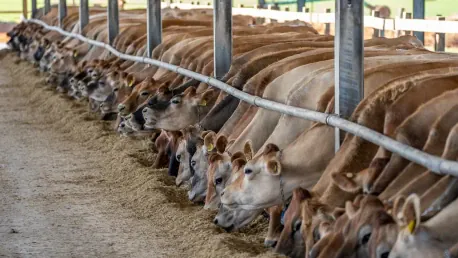New Zealand’s dairy sector, renowned worldwide for its superior quality and significant economic contribution, is undergoing a transformative shift powered by data analytics. This sector has always been a crucial pillar of New Zealand’s economy, leveraging innovation to maintain its competitive edge. Data analytics now stands as a pivotal force in reshaping dairy farm operations, optimizing resource utilization, and enhancing sustainability in ways previously unimaginable.
Enhancing Productivity and Yield Optimization
Data analytics offers detailed insights into various aspects of dairy operations, enabling farmers to monitor feed quality, herd behavior, and milking patterns with unprecedented precision. These insights help identify and improve operational inefficiencies, leading to optimized resource allocation and a substantial boost in overall productivity. Predictive tools play a vital role in anticipating peak production periods, allowing farmers to proactively address potential bottlenecks. For instance, a dairy farm based in Waikato reported a 20% increase in milk yield after adopting data-driven feeding strategies, which resulted in significant cost reductions and enhanced profitability.
Improving Animal Health and Welfare
Wearable sensors and advanced algorithms have become invaluable tools in providing real-time insights into livestock health, helping to minimize disease outbreaks and ensure animal welfare. These advanced tools assist in early detection of health issues, optimizing breeding cycles, and understanding behavioral anomalies that may indicate underlying problems. AgResearch, for example, has developed a sensor system capable of detecting illnesses like mastitis up to 48 hours before visible symptoms appear, thereby reducing veterinary costs and improving milk quality.
Enabling Efficient Resource Management
Data analytics is significantly empowering farmers to manage water, energy, and feed more effectively by offering real-time insights into resource utilization. Smart irrigation systems, powered by analytics, optimize water consumption, while energy analytics enable more efficient electricity use. These technologies help reduce waste and lower operational costs. A notable example is a dairy farm in Canterbury that reduced its water consumption by 30% using an analytics-driven irrigation system, showcasing the potential for substantial resource conservation.
Boosting Traceability and Supply Chain Efficiency
With consumers increasingly demanding transparency, data analytics provides end-to-end visibility of the dairy supply chain, ensuring product quality and compliance with export standards. Real-time tracking systems build consumer trust by ensuring that products meet stringent quality standards and boosting global competitiveness. Fonterra, a leading dairy company, employs blockchain and analytics to offer detailed provenance information, guaranteeing high compliance with export regulations and enhancing consumer confidence in their products.
Driving Sustainability and Reducing Environmental Impact
Achieving and maintaining environmental sustainability is a global objective, and data analytics is playing a crucial role in helping New Zealand’s dairy farms align with these goals. By measuring and minimizing their environmental footprint, these farms can adopt more eco-friendly practices. Tools for monitoring greenhouse gas emissions and optimizing waste management are particularly useful. A Taranaki farm exemplified this by implementing a methane-tracking system that led to a 15% reduction in emissions within a year, highlighting the impact of data analytics on environmental stewardship.
Common Themes and Overarching Trends
The integration of real-time data and advanced technological solutions is critical for enhancing productivity, improving animal health, ensuring sustainability, and boosting supply chain efficiency within New Zealand’s dairy sector. Predictive analytics and advanced monitoring tools facilitate proactive decision-making, leading to significantly improved operational outcomes. There’s a growing emphasis on sustainability and environmental responsibility, supported heavily by data analytics, to reduce the sector’s carbon footprint and enhance its global reputation.
Challenges and Future Outlook
Despite its numerous benefits, the adoption of data analytics in the dairy sector faces several obstacles. High initial costs and substantial capital investments are significant barriers, especially for small to medium-sized farms. Additionally, interpreting data insights effectively requires technical expertise, creating a need for comprehensive training programs. To safeguard farm operations and maintain consumer trust, ensuring data security is also critical.
Predicted Advancements
There are several advancements expected in the near future. The development and increased adoption of cost-effective and user-friendly analytics tools is anticipated, along with the expansion of government incentives to support sustainable farming practices and precision agriculture. Enhanced collaboration among technology companies, research institutions, and farmers will likely produce tailored solutions for New Zealand’s dairy sector. There will also be a focused effort on education and training to close knowledge gaps and promote the use of data-driven tools.
Main Findings
New Zealand’s dairy industry is globally acclaimed for its outstanding quality and significant economic contributions and is now undergoing a transformative shift driven by data analytics. Traditionally a key pillar of New Zealand’s economy, the dairy sector has continuously leveraged innovation to maintain a competitive edge. Nowadays, data analytics is playing a central role in revolutionizing dairy farm operations. By utilizing advanced data analysis techniques, farmers can optimize the use of resources such as water, feed, and land, consequently improving efficiency and productivity. Moreover, these technologies are promoting enhanced sustainability practices that were once considered unachievable. From precision farming to predicting animal health and productivity, data analytics is paving the way for smarter, more sustainable farming methods. Overall, this integration of technology represents a significant step forward for the industry, ensuring that New Zealand’s dairy sector remains at the forefront of global dairy production and continues to thrive in an increasingly competitive market.









